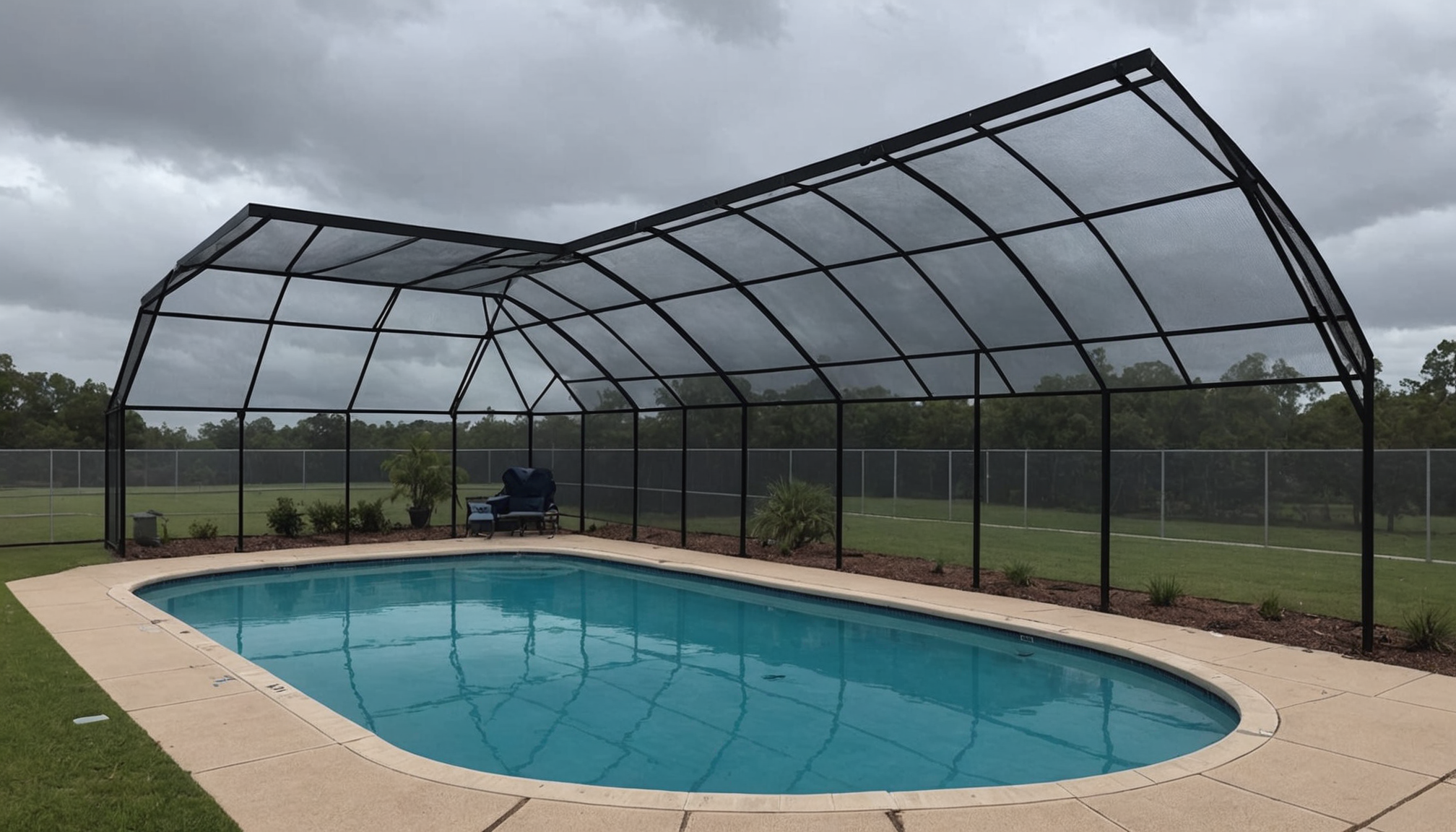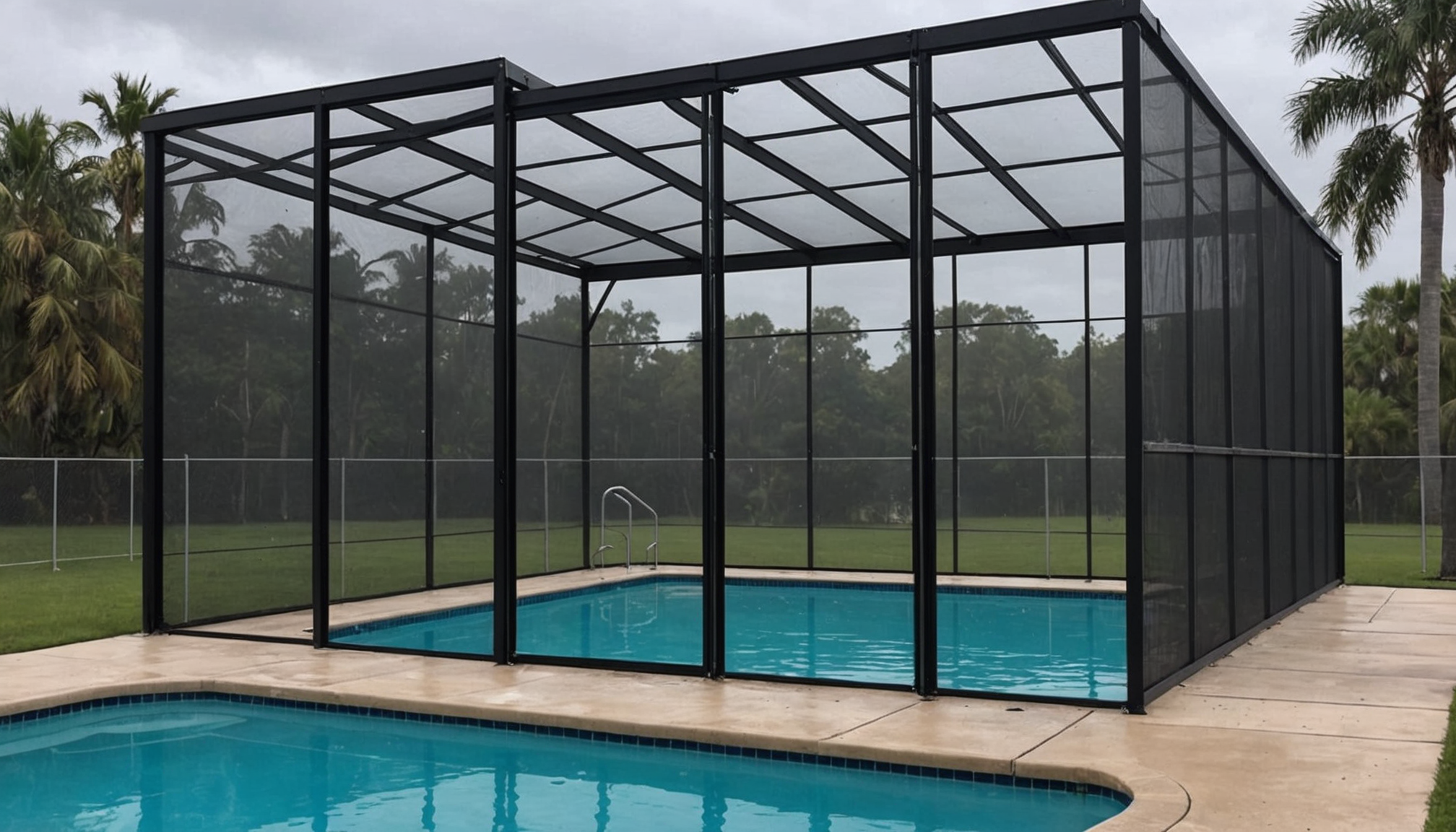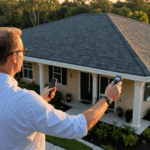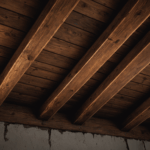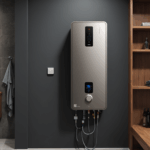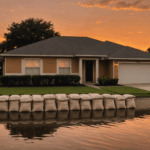According to the National Weather Service, Tampa experiences an average of 25 thunderstorm days annually, with peak activity during the summer months. These storms can wreak havoc on pool screen enclosures, making damage assessment a critical first step in the restoration process.
When evaluating storm damage to your pool screen enclosure, start with a systematic inspection of the entire structure. Pay particular attention to these key areas:
- Screen mesh integrity – look for tears, holes, or separations from the frame
- Aluminum framework – check for bent or twisted posts, beams, and fasteners
- Corner connections and splines – examine for separation or loosening
- Anchoring points – inspect concrete fasteners and base connections
- Door mechanisms – test functionality and alignment
The Florida Building Code requires pool screen enclosures to withstand wind speeds of up to 130 mph in Tampa’s coastal areas. However, the Insurance Institute for Business & Home Safety reports that even properly installed screens can sustain damage from flying debris during severe storms. Document all damage thoroughly with photographs and detailed notes, as this information will be crucial for insurance claims and repair planning.
Safety hazards require immediate attention. Look for sharp edges on damaged aluminum frames, loose screen sections that could detach in subsequent winds, and compromised structural components that might lead to collapse. The University of Florida’s Extension Service recommends conducting this assessment from both inside and outside the enclosure to ensure no damage goes unnoticed.
Measure the extent of damage using these categories:
- Minor: Small tears or holes in screening, slightly bent frames
- Moderate: Multiple screen panels damaged, partially bent frames, loose fasteners
- Severe: Structural damage, collapsed sections, multiple bent or broken frames
Professional inspectors from the Tampa Bay Builders Association suggest creating a detailed damage map of your enclosure, marking each affected area with specific notes about the type and severity of damage. This documentation will help streamline the repair process and ensure accurate cost estimation for either insurance claims or out-of-pocket repairs.
Emergency repair considerations
When severe weather strikes Tampa, taking immediate action to address storm damage to your pool screen enclosure is crucial to prevent further deterioration and maintain safety. Temporary solutions can help protect your property while you arrange for permanent repairs.
First, remove any debris that could cause additional damage to the screen or framework. Large branches, palm fronds, or other storm-blown items should be carefully cleared away to prevent them from creating new tears or punctures during subsequent winds. If you notice loose screening, secure it temporarily with heavy-duty tape designed for outdoor use to prevent further tearing.
For emergency structural issues, use hurricane straps or heavy-duty zip ties to temporarily secure loose framework components. However, these solutions should only serve as short-term fixes until proper repairs can be implemented. The Tampa Building Code emphasizes that temporary repairs must not compromise the overall structural integrity of the pool enclosure.
In cases where large sections of screening are damaged, consider using pool screen patch kits or temporary tarps to maintain some protection from debris and insects. These materials can be found at local home improvement stores throughout Tampa and can effectively bridge the gap until professional repairs are possible.
Water accumulation around the base of the enclosure requires immediate attention to prevent foundation issues. Create temporary drainage pathways to direct water away from the structure, and inspect the area regularly after subsequent rainfall to ensure proper water flow.
- Keep a storm repair kit ready with items like screen patches, outdoor tape, and zip ties for immediate emergency fixes
- Document all temporary repairs with photos and notes for insurance purposes
- Contact your insurance provider within 24-48 hours of storm damage to initiate claims
- Secure any loose materials that could cause additional damage during future storms
Remember that safety should always be the primary concern when implementing emergency repairs. If the damage appears severe or the structure seems unstable, it’s better to secure the area and wait for professional assistance rather than risk personal injury attempting repairs during potentially dangerous conditions.
Common repair techniques and materials
When repairing storm damage to Tampa pool screen enclosures, using the right techniques and materials is crucial for lasting results. Many homeowners make the mistake of using standard window screening material, which isn’t designed to withstand Florida’s harsh weather conditions. Instead, opt for 18/14 mesh screening specifically manufactured for pool enclosures, which offers better durability and wind resistance.
Another common error is using incorrect spline sizes. The rubber spline that holds the screen in place must match the channel size of your frame exactly. Using a spline that’s too small results in loose screening, while an oversized spline can damage the frame channels. Most Tampa pool enclosures use .175″ or .160″ spline, but always measure your existing spline before purchasing replacements.
For frame repairs, avoid using standard steel fasteners, which will quickly corrode in Florida’s humid climate. Instead, use stainless steel or aluminum fasteners rated for outdoor use. Many DIY repairers make the mistake of mixing different metals, leading to galvanic corrosion. Always match your fastener material to your frame type.
Essential repair materials include:
- Super Screen™ or Phifer 18/14 mesh screening
- Appropriate-sized spline and spline roller tool
- Aluminum frame patches and corner braces
- Stainless steel screws and bolts
- Screen repair tape for temporary fixes
One of the biggest mistakes is rushing the repair process without proper preparation. Always clean the frame channels thoroughly before installing new screening, and ensure all bent or damaged frame sections are properly straightened or replaced. Skipping these steps often leads to premature failure of the repair.
The screen installation technique itself requires careful attention. A common error is pulling the screen too tight during installation, which can cause warping or tearing around the edges. Maintain even tension while rolling the spline, working from the center outward to prevent wrinkles and ensure proper fit.
Professional vs diy repair options
When faced with pool screen repairs after Tampa storms, homeowners often wrestle with the decision between DIY repairs and professional services. While minor repairs might seem manageable, understanding the scope of work and your personal capabilities is crucial for making an informed choice.
DIY repairs can be cost-effective for simple issues like:
– Small screen tears under 6 inches
– Replacing individual screen panels
– Tightening loose fasteners
– Installing new spline in undamaged frames
– Minor frame adjustments
However, professional services become necessary for:
– Structural damage to aluminum framing
– Multiple panel replacements
– Roof section repairs
– Foundation or anchor point issues
– Insurance claim-related repairs
Cost considerations vary significantly. DIY screen panel replacement typically runs $50-100 per panel in materials, while professional services for the same work might cost $200-300. However, attempting complex repairs without proper expertise can lead to costly mistakes and potential safety hazards.
Licensed contractors in Tampa bring several advantages:
– Knowledge of local building codes
– Proper insurance coverage
– Professional-grade materials
– Warranty protection
– Expertise in storm damage assessment
– Proper safety equipment and procedures
Before attempting DIY repairs, evaluate:
– Your physical capabilities and comfort with heights
– Available tools and equipment
– Time commitment required
– Understanding of proper repair techniques
– Weather conditions and timing
– Insurance policy requirements
Remember that some insurance policies require professional repairs to maintain coverage. Additionally, improper repairs to pool screen enclosures can void warranties and potentially create liability issues. For repairs exceeding basic maintenance, working with licensed Tampa contractors often proves more cost-effective in the long run.
Consider starting with simpler repairs while leaving complex structural work to professionals. This balanced approach helps develop maintenance skills while ensuring your enclosure remains safe and properly restored after storm damage.
Prevention and weatherproofing tips
- How can I protect my pool screen enclosure during Tampa’s storm season?
- Regular maintenance and reinforcement of vulnerable areas are essential preventive measures. Install hurricane braces on key structural points and ensure all fasteners are properly tightened before storm season begins.
- What’s the best way to strengthen my screen enclosure against high winds?
- Professional-grade wind abatement systems can be installed to reduce wind pressure on your enclosure. These systems, combined with impact-resistant screening material and reinforced corner brackets, significantly improve storm resistance.
- How often should I inspect my pool screen enclosure for potential weak points?
- Conduct thorough inspections at least quarterly, with additional checks before and after major storms. Pay special attention to fasteners, splines, and frame connections, as these are common failure points during severe weather.
- What type of screening material offers the best protection against Tampa storms?
- High-quality polyester or PVC-coated mesh specifically designed for Florida’s climate provides optimal durability. Look for materials rated for high wind resistance and UV protection, such as Phifer’s Super Screen or similar commercial-grade products.
- Are there any seasonal maintenance steps I should take to prevent storm damage?
- Before hurricane season, trim nearby trees and remove potential projectiles from your yard. Apply lubricant to door mechanisms and check anchor points in the concrete foundation for signs of wear or loosening.
